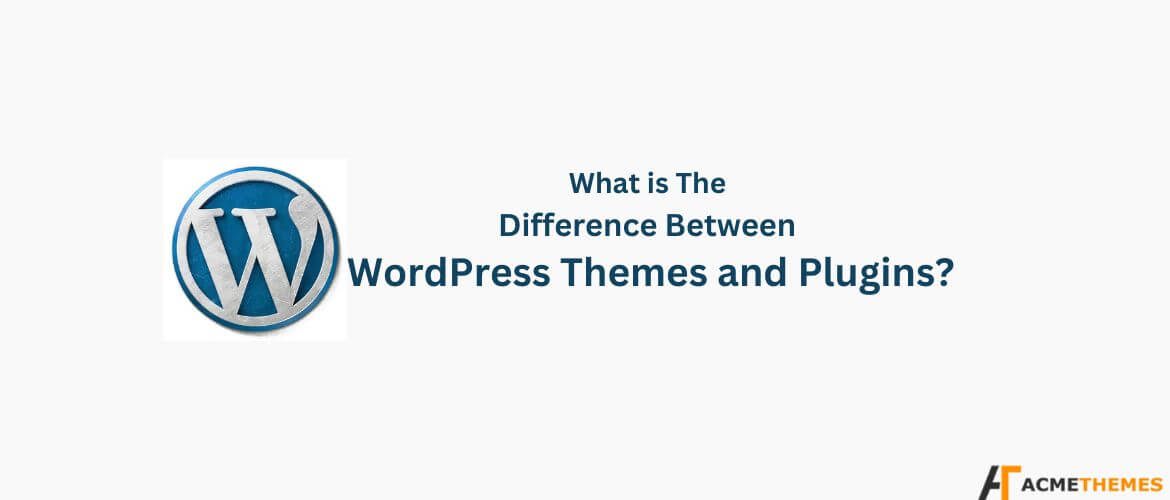What is The Difference Between WordPress Themes and Plugins?
WordPress, a popular content management system, offers many tools and functionalities to simplify website creation and management. Two of the crucial components in the WordPress ecosystem are themes and plugins. While both play determining roles in shaping the functionality and appearance of a WordPress site, they provide distinct purposes. In this article, we will explore the key differences between WordPress themes and plugins, dispersing light on their respective functionalities and how they contribute to the overall website experience.
Table of Contents
Defining Themes and Plugins:

WordPress Themes
A theme in WordPress dictates the overall design, layout, and visual appearance of a website. It regulates how the site is structured, the fonts and colors used, the placement of content, and other expressive elements. Themes provide a connected/cohesive framework that enables you to create a consistent and visually appealing website. They usually come with built-in features and templates, enabling easy customization and providing a foundation for your website’s aesthetics.
WordPress Plugins
Plugins, on the other hand, are additional software components that broaden the functionality of your WordPress site behind what the core system offers. Plugins are like add-ons that strengthen specific features or provide new capabilities. They enable you to integrate advanced functionalities such as contact forms, e-commerce systems, search engine optimization (SEO) tools, social media sharing, security enhancements, and much more. Plugins enable customization and development of your website’s functionality without requiring deep coding knowledge.
Key Differences:
| Criteria | Themes | Plugins |
|---|---|---|
| Purpose | Define the overall design and layout of a website | Extend and enhance the functionality of a website |
| Function | Control visual appearance and user interface elements | Add new features, tools, and functionality to a website |
| Customization | Offer pre-designed templates and customization options | Extend or modify existing features based on specific needs |
| Scope | Affects the entire website or a specific section | Can be applied to the entire website or specific areas |
| Dependency | Not dependent on any particular plugin | Can depend on other plugins or require specific ones |
| Activation | Activate and apply to the entire website | Activate and configure individually for desired functions |
| Examples | WordPress themes, templates, and styles | SEO plugins, contact form plugins, social media plugins |
Differences:
Purpose
Themes essentially focus on the visual presentation and layout of your website. They regulate the overall look and feel, ensuring consistency across pages and posts. Themes help set up branding and convey the appropriate user experience. On the other hand, plugins are developed to add specific features and functionality to your website, serving various needs such as SEO, e-commerce, security, performance optimization, and more.
Scope of Impact
Themes have an inclusive impact on your website as they affect its entire appearance. By changing the theme, you can immediately transform the visual design and layout of your site. However, Plugins target specific areas or functionalities. You can install and activate plugins to add or amplify specific features without significantly modifying the overall look and structure of your website.
Customizability
Themes commonly offer customization options related to design elements, such as color schemes, fonts, and layouts. They may include theme options panels or visual builders that allow you to personalize your website’s appearance. On the other hand, Plugin provides customization options related to specific functionalities. For example, an SEO plugin may enable you to optimize meta tags, generate sitemaps, or manage social sharing settings.
Dependency
Themes are a fundamental part of your website and are required for it to function correctly. Changing themes frequently leads to a significant visual overhaul of the site. Plugins, on the other hand, can be activated or deactivated on their own without affecting the core functionality or design. They provide versatility in adding or removing features as per your requirements.
Conclusion
WordPress themes and plugins play distinct roles in shaping your website’s display and functionality. Themes focus on the visual design, layout, and overall user experience, providing a compatible look across your site. Plugins, on the other hand, expand the potentiality of your website by adding specific features and functionalities that are appropriate to your needs. Understanding the differences between themes and plugins is crucial for successfully utilizing the power of WordPress and creating a website that meets both aesthetic and functional requirements. By effectively playing with themes and plugins, you can build a dynamic and engaging online presence tailored to your unique vision and goals.
Check out our other recent article:
